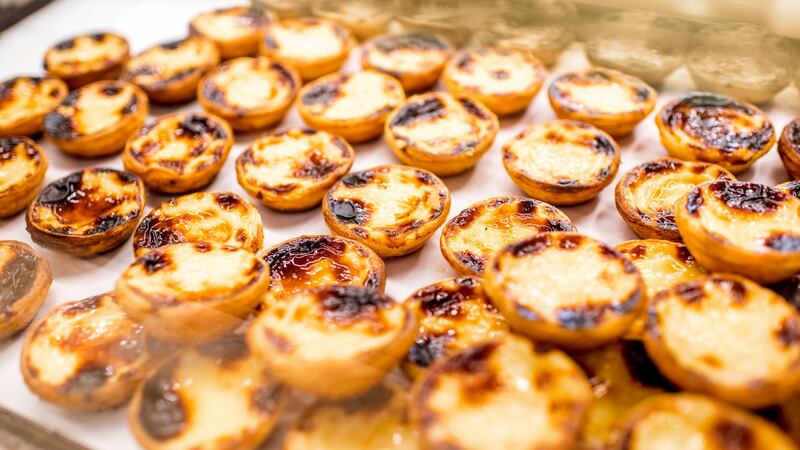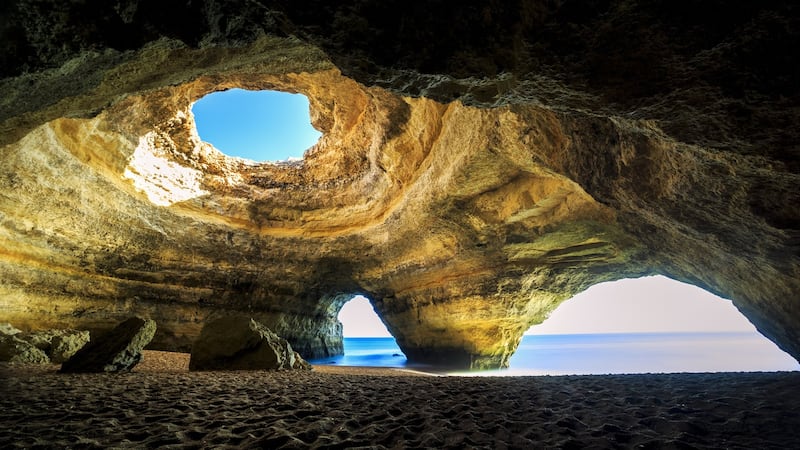Hurtling around Portugal’s capital city on a tuk tuk tour gives you a real sense of the grand colonial history of the place and the stark contrast that draws to its current economic woes.
There are beautifully restored old relics commemorating the Portuguese age of discovery dotted all over Lisbon.
There are maritime museums, monasteries and restored naval yards which remind you of where these people came from.
It makes you wonder if they are hard to look at for locals, who have been subjected to a severe economic recession, the IMF and a particularly low minimum wage – just €677 a month.
Our rickety petrol-powered tuk tuk grinds to a halt outside the Jeronimos Monastery in the Belem region of Lisbon where our guide, Rui, hops out and explains the significance of the site.
It is a grandiose structure built on the banks of the Tagus river at the end of the 15th century and has throngs of tourists queuing up to get a glance inside.
“It is from the old times when we were rich and really powerful; we’re not anymore,” says Rui from Tuk Dreams tours with a wry laugh.
The Maritime Museum is located in the west wing of the monastery – a Unesco world heritage site – and is a really good lesson in the naval history of the place.
There are scale models of ships from the 1600s as well as a wooden figure of Archangel Raphael that accompanied Vasco da Gama on his voyage to India.
There are ceremonial barges from the 18th century and replica 16th century maps showing the world as it was thought to be then.
Pastries
But never mind all that, more importantly, it was here in the Jeronimos Monastery that the delicious pasteis de nata originated – a custard-filled pastry which the monks used to make with leftover egg yolks.
The most famous place to buy the pastries today is in Pasteis de Belem, a bakery beside the monastery which traces its origins back to the 1800s when monks began selling their pastries there.

However, Pastelaria Aloma, a small and unassuming looking bakery in the Campo de Ourique neighbourhood, is now known for selling the tastiest versions. Don’t trek for hours searching for these places though; I thought they were delicious everywhere we went.
If, like me, you find yourself back in Ireland and craving the little beauties, you can get them in any Nandos or at The Bakery by The Cupcake Bloke in Rialto, Dublin 8.
Another delicacy to be savoured here is the seafood – crab sold by the pound, octopus in salads and calamari without the rubberiness.
The Portuguese like to take their time over food; several small portions are shared between the table and there is always an accompanying glass of wine.
"We sit and eat, we don't grab and go," one of the locals told us, as a large group of us shared casquinha de santola – a creamy crab dip served cold in a spider crab shell – as well as cold crab claws and garlic clams at the Cervejaria Liberdade restaurant in the posh part of town.
Food on a budget
You don't have to spend a fortune to eat like a king here, though. Time Out has a fresh food market at Mercado de Ribeira where you can try local specialities from some of the finest food outlets in town, including pasteis de nata from Aloma.
Jose Avillez, a renowned Portuguese chef with two Michelin stars, has a number of restaurants across the city to cater for all different budgets.
We went to Cantina Ze Avillez, where main courses start at €13, and the food was delicious. Don’t leave without trying the hazelnut ice-cream with its drool-worthy hazelnut foam.
The tuk tuk tour is a really great way of getting a good overview of the city very quickly. An extensive tour took us about three hours and cost €23.50 per person in a group of six.

Make sure you ask them to bring you to a miradouro – which means viewpoint. There are plenty of them across the city and each will give you a different angle of this beautifully ochre city.
The tuk tuk tour will give you a taste of the places you might want to go back to for a little more exploring.
The Algarve
If, however, you’re looking to expand your trip further afield than the Portuguese capital, the Algarve is only a three-hour drive away.
We combined the two as part of one trip which gave a lovely balance of city buzz and seaside rest.
Carvoeiro is a tiny little town which hugs the cliffside coast of the Algarve. It is about a 50-minute drive from Faro airport and offers a much more laid-back vibe than other stag-filled Algarve resorts.
There is a focus on getting out and about here; think clear heads and early nights, not tequila shots and accidental sunrises.
The coastline is stunning and its towering sea stacks and hallowed caves serve as the town’s main point of attraction.
We stayed at the Tivoli Carvoeiro, a modest enough looking place from the entrance but with a show-stopping view of the seaside once you walk through its doors.
The hotel clutches the cliff edge of Carvoeiro and every room looks out onto this stunning view.
There is the added perk of a Voya spa here too, which offers a range of massages and treatments using the Irish seaweed beauty brand.
You will, of course, pay well for its five-star luxury and pleasing views; this is a hotel popular among honeymooners and men with wobbly knees.
Regardless of where you stay in this little town, there are plenty of ways to enjoy the beautiful coastline besides just looking at it.
Walking tours
We took a walking tour across the Seven Hanging Valleys, a 5km signposted route that runs across the cliffs from Centeanes to Marinha beach.
It passes the Alfanzina lighthouse and Benagil beach, home to the photogenic Benagil sea caves, which are really worth a trip out to in their own right.

You can take a boat tour from Carvoeiro beach or, for something a bit different, you could do a stand-up paddle board tour from Benagil village with seabookings.com.
Along the Hanging Valley walk you will also find a very romantic looking little set of table and chairs that look like leftovers from a movie set, as well as lots of other picturesque nooks and crannies in which to rest your bones.
Algar Seco, a series of cliff formations, is another spot worth visiting in Carvoeiro. It has a boardwalk by the sea as well as one of the most famous viewpoints in the town, called “a boneca”, which means doll in Portuguese.
The two arches carved into the limestone, which look like a pair of beady eyes, immediately give away the reason for the name.
Similar to Lisbon, there is a real focus on seafood here, and local wines.
We did a wine tasting tour at Cabrita Wines in Silves, a 20-minute drive from Carvoeiro, that included a cheeseboard per person and more than just a "taste" of wine.
Make sure you arrange a taxi home instead of driving if you really want to enjoy this properly.
The wine is plentiful in Portugal, and cheap; the food is fresh and light; and the sea air is at once exhausting and rejuvenating.
Lisbon is full of history, heritage and art while the Algarve offers a peace like no other – you just have to seek it out.
Niamh Towey was a guest of Grifco PR at the Tivoli Avenida Liberdade Lisboa and the Tivoli Carvoeiro.
Fact box
How to get there: Return flights into Lisbon and out of Faro from Dublin start at €182 for a week in September with Aer Lingus.
Where to stay: Nightly rates at Tivoli Avenida Liberdade Lisboa start from €200 for a double room on B&B basis. For more information, visit: iti.ms/2AZGM9B
Nightly rates at Tivoli Carvoeiro start from €120 for a double room on B&B basis. For more information, visit: iti.ms/2P02ugr











